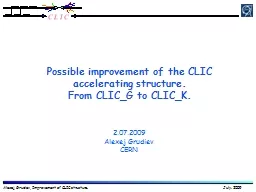

Possible improvement of the CLIC accelerating structure From CLICG to CLICK 2 072009 Alexej Grudiev CERN Outline Current CLIC accelerating structure CLICG Compact coupler design with damping ID: 763556
Download Presentation The PPT/PDF document "Possible improvement of the CLIC acceler..." is the property of its rightful owner. Permission is granted to download and print the materials on this web site for personal, non-commercial use only, and to display it on your personal computer provided you do not modify the materials and that you retain all copyright notices contained in the materials. By downloading content from our website, you accept the terms of this agreement.
Possible improvement of the CLIC accelerating structure. From CLIC_G to CLIC_K. 2 .07.2009 Alexej Grudiev CERN
Outline Current CLIC accelerating structure: CLIC_GCompact coupler design with damping Comparison of rounded and not rounded cell geometryNew type of waveguide damping for lower pulsed surface heating – a ridged waveguide damping Constant Sc structure as an optimally tapered accelerating structure
Parameters of CLIC_G Structure CLIC_G Frequency: f [GHz]12Average iris radius/wavelength: <a>/λ 0.11Input/Output iris radii: a1,2 [mm]3.15, 2.35Input/Output iris thickness: d1,2 [mm]1.67, 1.00Group velocity: vg(1,2)/c [%]1.66, 0.83N. of reg. cells, str. length: Nc, l [mm]24, 229Bunch separation: Ns [rf cycles]6Luminosity per bunch X-ing: Lb× [m-2]1.22×1034Bunch population: N3.72×109Number of bunches in a train: Nb312Filling time, rise time: τf , τr [ns]62.9, 22.4Pulse length: τp [ns]240.8Input power: Pin [MW]63.8Pin/CtPp1/3[MW/mm ns1/3]18Max. surface field: Esurfmax [MV/m]245Max. temperature rise: ΔTmax [K]53Efficiency: η [%]27.7Figure of merit: ηLb× /N [a.u.]9.1
WDS cell geometry Waveguide Damped Structure (WDS) 2 cells Minimize E-field Minimize H-field Provide good HOM damping Provide good vacuum pumping
TD24_vg1.8_disk
TD24_vg1.8_disk transverse wake
Parameters of TD24_vg1.8_disk Structure CLIC_G TD24 Frequency: f [GHz]1212Av. iris radius/wavelength: <a>/λ 0.110.11In/Output iris radii: a1,2 [mm]3.15, 2.353.15, 2.35In/Output iris thickness: d1,2 [mm]1.67, 1.001.67, 1.00Group velocity: vg(1,2)/c [%]1.66, 0.831.62, 0.81N. of reg. cells, str. length: Nc, l [mm]24, 22924, 229Bunch separation: Ns [rf cycles]66Lumi. per bunch X-ing: Lb× [m-2]1.22×10341.22×1034Bunch population: N3.72×1093.72×109Number of bunches in a train: Nb312312Filling time, rise time: τf , τr [ns]62.9, 22.464.2, 23.1Pulse length: τp [ns]240.8242.7 Input power: P in [MW] 63.8 66.0 P in /Ct P p 1/3 [MW/mm ns 1/3 ] 1818.6Scmax [MW/mm2]5.45.6Max. surface field: Esurfmax [MV/m]245240Max. temperature rise: ΔTmax [K]5362Efficiency: η [%]27.726.5Figure of merit: ηLb× /N [a.u.]9.18.7 Parameters assuming coupler overhead
Electric field coupler
Magnetic field coupler with damping Courtesy of R. Zennaro compact coupler (CC)
CLIC_G + compact coupler CLIC_G CLIC_GCC Prototype is under design
Rounded and non-rounded damped cells CLIC_G rounded idw = 8.75 mm adw = 11.25 mm CLIC_G non-roundedidw = 8.2 mmadw = 10.1 mmTD18 cell
Ridged waveguide for HOM damping Rectangular waveguide Double-ridged waveguide R idged waveguide CLIC_GLDT (low ΔT)idw = 7.5 mmadw = 9.25 mmidwadw
EM field configuration in RWDS Electromagnetic field configuration on the surface of a Ridged waveguide damped structure (RWDS) cell Electric field Magnetic field Sc
Structures with ridged waveguide damping CLIC_GLDT : a = 3.15 – 2.35 mm CLIC_K : a = 3.3 – 2.35 mm
Wake field of proposed structures
Transverse impedance
Parameters of the structures Structure CLIC_G CLIC_GCC CLIC_GCC non-rounded CLIC_GLDTCLIC_KFrequency: f [GHz]1212121212Average iris radius/wavelength: <a>/λ 0.110.110.110.110.113Input/Output iris radii: a1,2 [mm]3.15, 2.353.15, 2.353.15, 2.353.15, 2.353.3, 2.35Input/Output iris thickness: d1,2 [mm]1.67, 1.001.67, 1.001.67, 1.001.67, 1.001.67, 1.00Group velocity: vg(1,2)/c [%]1.66, 0.831.66, 0.831.67, 0.841.68, 0.861.97, 0.86N. of reg. cells, str. length: Nc, l [mm]24, 22925, 22525, 22525, 22525, 225Bunch separation: Ns [rf cycles] 6 6 6 6 6 Luminosity per bunch X- ing : L b × [m -2 ] 1.22×10341.22×10341.22×10341.22×10341.28×1034Bunch population: N3.72×1093.72×1093.72×1093.72×1093.94×109Number of bunches in a train: Nb312312 312 316 326 Filling time, rise time: τ f , τ r [ns] 62.9, 22.4 64.7 , 22.4 63.8, 22.0 63.0, 21.6 58.4 , 21.6 Pulse length: τ p [ns] 240.8 242.6 241.4 242.1 242.5 Input power: P in [MW] 63.8 59.8 61.5 61.3 64.6 (65.2) P in /Ct P p 1/3 [MW/mm ns 1/3 ] 17.9 16.8 17.3 17.3 17.5 S c max [MW/mm 2 ] 5.45.15.35.25.1Max. surface field: Esurfmax [MV/m]245233230230244Max. temperature rise: ΔTmax [K]5348453937Efficiency: η [%]27.728.828.128.529.5 (29.2)Figure of merit: ηLb× /N [a.u.]9.19.49.39.49.6 (95% of Cu conductivity)
Proposal for new test structuresCLIC_GCC non-rounded: TD25_vg1.7_disk - an optimized version of TD24-type made in standard disk technology the same as TD18-type. CLIC_GLDT: TD25_vg1.7_dLDT – structure with ridged waveguide damping CLIC_K: T25_vg2_disk – non-damped structure with higher input group velocity and stronger tapering than CLIC_GTD25_vg2_disk – damped version
RF breakdown constraints Constraints @ {200ns, BDR=10 -6 bpp /m} ~ {180ns, BDR=3x10-7 bpp/m}